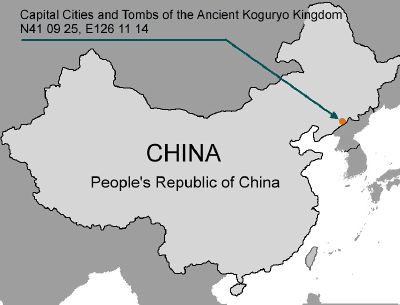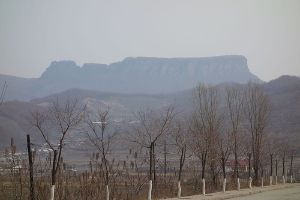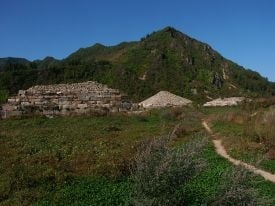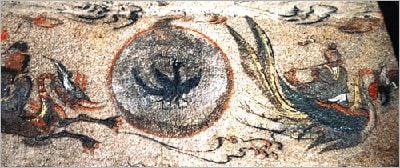Capital Cities and Tombs of the Ancient Koguryo Kingdom
| Capital Cities and Tombs of the Ancient Koguryo Kingdom* | |
|---|---|
| UNESCO World Heritage Site | |
| State Party | |
| Type | Cultural |
| Criteria | i, ii, iii, iv, v |
| Reference | 1135 |
| Region** | Asia-Pacific |
| Inscription history | |
| Inscription | 2004 (28th Session) |
| * Name as inscribed on World Heritage List. ** Region as classified by UNESCO. | |
| This article contains Chinese text. Without proper rendering support, you may see question marks, boxes, or other symbols instead of Chinese characters. |
Capital Cities and Tombs of the Ancient Koguryo Kingdom, located in and around Ji'an, Jilin in the People's Republic of China, received UNESCO's World Heritage Site designation. The site contains the archaeological remains of three cities (Wunu Mountain City, Guonei City, and Wandu Mountain City), and forty identified tombs of Koguryo imperial and noble families. Until recently, little has been known about the origin of Korea in the northern regions of China and in North Korea. At the end of the Joseon Dynasty, in the late nineteenth century, China had become protective of the northern regions historically claimed by Korea. China and Joseon signed an agreement that the movement of Koreans into Manchuria would be a crime punishable by death. Still, Koreans migrated secretly into the historic region of Korea's origin, the area of Tangun Joseon, Kija Joseon, and Koguryo.
The fall of the Berlin Wall in 1989, and the turning away from communism by the Chinese government that followed, opened a new era for archeology. With the approach of the Olympics in the summer of 2008, China has been gradually opening to archeological investigation. UNESCO designated the Capital Cities and Tombs of the Ancient Koguryo Kingdom a World Heritage Site in 2004. China's opening the region to archeology constituted a brave act on their part. The discovery and excavation of the original capital cities of the Korean empire, dating to at least the time of Christ, reopens the question of ownership of the region, at least for scholars. Some Korean scholars argue that Korea, especially North Korea, has claim to the area while some Chinese scholars argue that the early dynasties had been Chinese provinces, not Korean kingdoms. In any case, the argument seems academic since the governments of China, North Korea, and South Korea are content to leave borders where they are.
Capital Cities

Wunu Mountain City served as the first capital of Koguryo (Goguryeo) Kingdom. Guonei City (Gungnae-seong) and Wandu Mountain City (Hwando) served at other times as the capital of the Koguryo Kingdom.[1] Wunu Mountain City has been only partly excavated. Guonei City, within the modern city of Ji’an, played the role of a supporting capital after the main Koguryo capital moved to Pyongyang. Wandu Mountain City contains many vestiges including a large palace and many tombs.[1]
The Capital Cities of the Koguryo Kingdom provide an early example of mountain cities, later imitated by neighboring cultures. The system of capital cities represented by Guonei City and Wandu Mountain City also influenced the construction of later capitals built by the Koguryo regime.[1] The capital cities of the Koguryo Kingdom represent an artistic blending of human creation and nature whether with the rocks or with forests and rivers.[1]
Wu Nu Shan
| Wu Nu Shan | |
|---|---|
 | |
| Elevation | 821 metres (2,693 ft) |
| Location | Liaoning, China |
| Geographic coordinates | 41°19.6′N 125°24.7′E |
| Easiest Climbing route | cable car |
Wu Nu Shan (Chinese: 五女山; pinyin: Wǔ Nǚ Shān), which means the mountain of Five Women, represents a mountain of historical and cultural significance located in the north of the town of Huanren, in Huanren Manchu autonomous county, Liaoning Province, China. The tallest peak, Main Peak, stands 821 meters high.
Wu Nu Shan has been considered the birthplace of the Korean Kingdom "Goguryeo" civilization and the last feudal dynasty—Manchu's Qing Dynasty. Its peculiar and beautiful landscapes have made it internationally famous in recent years.
History
Wu Nu Shan has a long history of human habitation. Recently archaeologists have found historical artifacts on the mountain, including pottery from the late Neolithic Age, more than 4500 years ago. Those artifacts also include some human-used weapons and tools which have been dated as thousands of years old. The Korean kingdom, Goguryeohad been founded in 37 year B.C.E above the mountain. Goguryeo moved the capital to Gungnae Seong in the year 3 B.C.E.. In 1424 C.E., when the third king of Jurchen Li Manzhu invaded Liao Ning, they quartered on that mountain and founded the Manchu kingdom.
Location
Wu Nu Shan situates in the northeast of Huanren County and the northwest of the Hun Jiang River, eight km from the county. Its main peak measures 821 meters above sea level, has a length of 1500 m from the north to the south side and a width of 300 m from the east to the west side.
Natural significance
Wu Nu Shan sits in the north temperate zone so the four seasons, enjoying four distinct season. More than sixty scenic spots populate the area. In the spring and summer, flowers, trees, butterflies and birds abound. The lake has a regular schedule of tourist ships during the summer. In autumn, red dominates the mountain, as the famous Chinese sweet gums come into season. At the end of the year, the mountain will appear to put on a white coat and become like a jade dragon lying beside the river.
Cultural significance
Wu Nu Shan, called "The First Defensive City Wall In The East," has all the elements of a defensive city wall—temple, palace, barn, barracks, water source, and a city wall of more than 200 meters above the relative sea level. The Goguryeo kingdom could quarter at the mountain as long as necessary during the cold weather seasons.[2]
Awards
- 1994, Awarded as the Most Protected Culture Relic
- 1999, One of the Top Ten National Archaeological Discovery
- 2002, Awarded as the AAAA Class National Tourist Spot
- 2004, Nominated on the UNESCO World Heritage List[2]
Gungnae-seong
Gungnae-seong, present-day Ji'an (集安), served as the second capital city of the ancient Kingdom of Goguryeo. The kingdom's second ruler, King Yuri, chose the site as the capital city during the tenth month of the year 3 C.E. Invaders sacked the city several times until the rise of the 19th ruler king Gwanggaeto the Great, who greatly expanded Goguryeo's territory and made it a formidable power in the northeast Asia. When King Gwanggaeto died during 413 C.E., his son, King Jangsu, inherited the throne and moved the capital south to Pyongyang in the year 427 C.E.
Gungnae-seong fell to the Silla-Tang alliance when General Yeon Namsaeng, son of Yeon Gaesomun, surrendered the city in 666 C.E. The kingdom of Goguryeo itself fell in 668 C.E. when Tang army captured Pyongyang and took King Bojang and Yeon Namgeon into custody.
Wandu Mountain City
Wandu Mountain City (Chinese: 丸都山城) (Korean transliteration: Hwando Mountain Fortress), along with Gungnae-seong (Guonei), served as the second capital of Goguryeo (Hanzhi: 高句麗, Pinyin: Gaogouli, Hangul: 고구려). Located 2.5 kilometers to the west of Ji'an, Jilin, China, UNESCO designated the remains of Wandu Mountain City part of a World Heritage Site.[1]
History
- "On October of the 22nd year (of Yuri of Goguryeo), the Yuri King moved the capital to Gungnae-seong, and built the Weina Rock fortress."[3]. Since the first year of Yuri of Goguryeo falls on 19 B.C.E., the 22nd year figures to 3 C.E. Gungnae-seong designated a fortress on Yalu River's plain, while Weina Rock fortress (尉那巖城) had been a fortified city in the mountain, later renamed to Hwando(丸都), by Sansang of Goguryeo.
- "On February of the 2nd year (of Sansang of Goguryeo), Hwando City was built." "On October (of the 13th year of Sansang of Goguryeo), the Sansang King moved the capital to Hwando".[4] Since the 1st year of Sansang of Goguryeo calculates 197 C.E., the 2nd year falls on 198 C.E. and the 13th year 209 C.E.
Tombs
The site includes archaeological remains of forty tombs: fourteen imperial tombs and twenty six nobles. The tombs host the remains of royalty in Koguryo, which ruled over parts of northern China and the northern half of the Korean Peninsula from 37 B.C.E. to 668 C.E.[1]
Some of the tombs have elaborate ceilings, wide spaces without columns, and carrying a heavy load of a stone or earth tumulus (mound) placed above them. The tombs, particularly the important stele and a long inscription on one of the tombs, shows influence of Chinese culture on Koguryo. The paintings in the tombs, while showing artistic skills and specific style, provide an example of strong influence from various cultures.[1] The tombs represent a masterpiece of the human creative genius in their wall paintings and structures.[1]
Notes
- ↑ 1.0 1.1 1.2 1.3 1.4 1.5 1.6 1.7 Capital Cities and Tombs of the Ancient Koguryo Kingdom UNESCO. Retrieved April 27, 2021.
- ↑ 2.0 2.1 The Historically Famous Wu Nu Shan baike.baidu.com. Retrieved April 27, 2021.
- ↑ Samguk Sagi (The History of the Three Kingdoms) Volume 13, 18.
- ↑ Samguk Sagi (The History of the Three Kingdoms) Volume 16, 21-23.
ReferencesISBN links support NWE through referral fees
- Chŏn, Ho-tʻae. The Dreams of the Living and Hopes of the Dead: Gogureo tomb murals. Seoul, Korea: Seoul National University Press, 2007. ISBN 9788952107299
- Kim, Lena. Koguryo Tomb Murals: World cultural heritage. Seoul: ICOMOS-Korea, 2004. OCLC 66479811
- Kim, Ri-na.. Koguryo Tomb Murals. Seoul, Korea: ICOMOS-Korea, 2004. OCLC 59009020
- Tongbuga Yŏksa Chaedan (Korea). Koguryo: A glorious ancient Korean kingdom in Northeast Asia. Seoul, Korea: Northeast Asian History Foundation, 2007. OCLC 173623530
- Veg, Sebastian. Preservation of the Koguryo kingdom tombs. S.l.: UNESCO, 2005. OCLC 71724726
External links
All links retrieved November 25, 2023.
| |||||||
Credits
New World Encyclopedia writers and editors rewrote and completed the Wikipedia article in accordance with New World Encyclopedia standards. This article abides by terms of the Creative Commons CC-by-sa 3.0 License (CC-by-sa), which may be used and disseminated with proper attribution. Credit is due under the terms of this license that can reference both the New World Encyclopedia contributors and the selfless volunteer contributors of the Wikimedia Foundation. To cite this article click here for a list of acceptable citing formats.The history of earlier contributions by wikipedians is accessible to researchers here:
- Capital_Cities_and_Tombs_of_the_Ancient_Koguryo_Kingdom history
- Wunü_Mountain history
- Gungnae-seong history
- Wandu_Mountain_City history
The history of this article since it was imported to New World Encyclopedia:
Note: Some restrictions may apply to use of individual images which are separately licensed.


